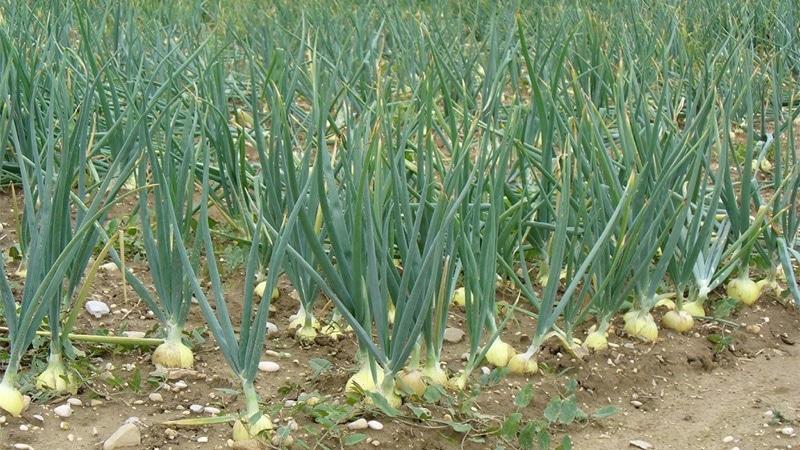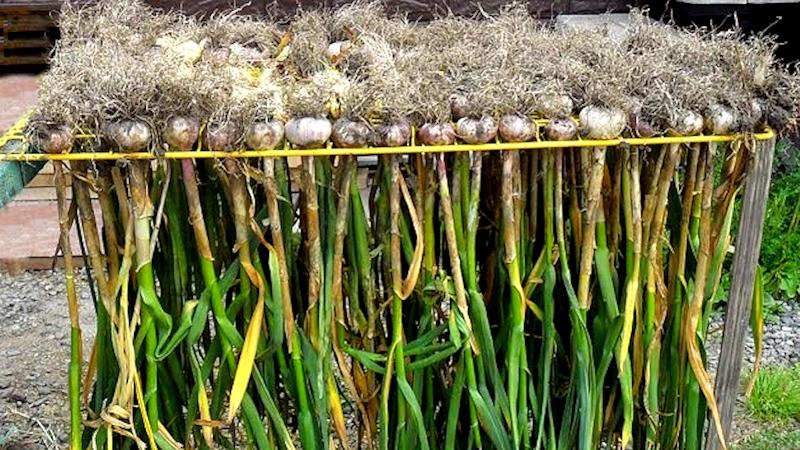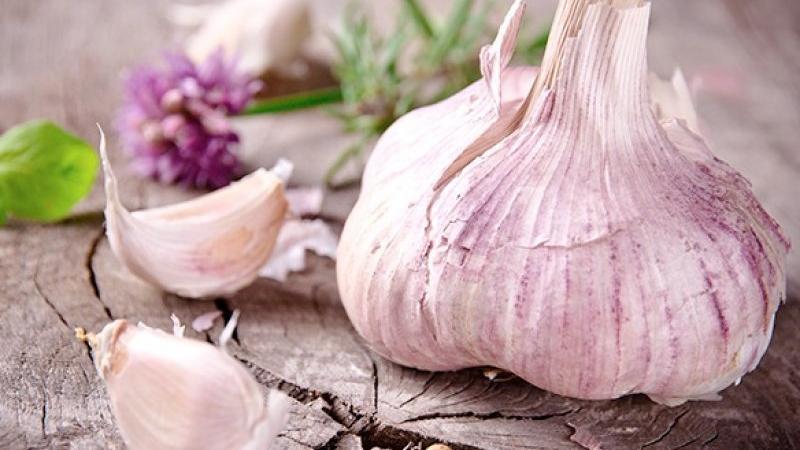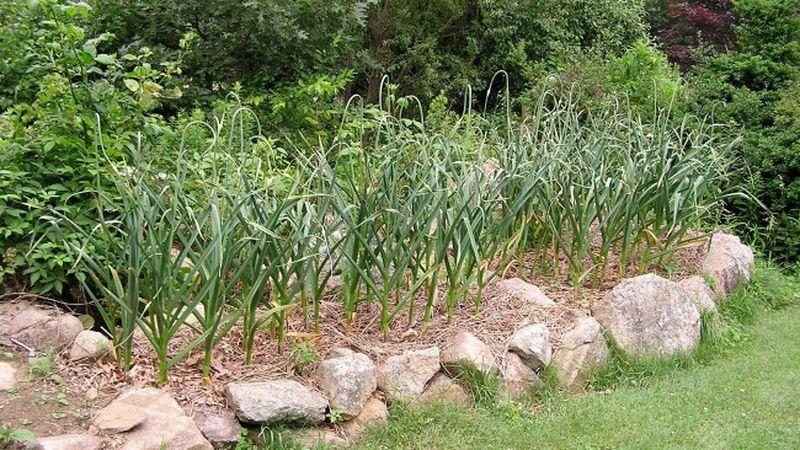A practical guide to growing garlic in a greenhouse: a technique from experienced gardeners
Growing garlic in greenhouses is less of a hassle than growing outdoors. The main thing is to control the climate so that the harvest does not depend on weather conditions. The winter variety is protected from freezing or early germination.
The spring variety tolerates spring frosts well, which makes it possible to plant them 1-2 weeks earlier. In the greenhouse, the garlic will not rot and will ripen faster. Proper crop care will bring a rich harvest.
The content of the article
- Benefits of growing garlic in greenhouses
- Garlic varieties suitable for greenhouse cultivation
- How to care for garlic for a good harvest
- Features of growing garlic: diseases and pests
- Planting with cloves and bulbs: what is the difference, what and when to choose
- Secrets and Tips
- Growing garlic in a greenhouse all year round as a business
- Conclusion
Benefits of growing garlic in greenhouses
The winter variety of garlic ripens during the summer when rain can cause rot. This spoils a lot of the crop. That is why many people prefer greenhouse conditions.
Reference. In the greenhouse, it is easier to control the climate and moisture, which significantly reduces the risk of disease.
Humidity should be no more than 70%. It is not necessary to heat the greenhouse for winter garlic, as this promotes premature germination. For the spring variety, a heated area is needed. In addition, in greenhouse conditions, the shooting of garlic is minimized.
Garlic varieties suitable for greenhouse cultivation
In the climatic conditions of Russia, two types of garlic are grown - winter and spring. They differ in appearance and cultivation method. So, winter garlic has teeth of the same size, located in one row around the trunk inside the head. A spring garlic bulb consists of a large number of cloves growing chaotically, the stem inside the head is not as strong as that of a winter garlic.
Spring garlic is planted in spring and harvested until mid-autumn. It reproduces with the help of teeth, arrows with air bulbs let only one variety of this variety.
Winter garlic is planted in late autumn and the fruits are harvested in the middle of summer. This species reproduces both by air bulbs and by teeth. But winter garlic does not store well. For these purposes, it is better suited spring.
Consider several varieties of garlic ideal for greenhouse or greenhouse cultivation:
- Gafurian. Non-darting, belongs to medium early varieties. The period from full germination to technical ripeness is 83–90 days. Head weight - 12-34 g, number of cloves - 16-18. The structure is complex, the pulp is dense.
- Komsomolets. A high-yielding species with a growing season of 120 days. Bulb weight - up to 30 g. It has from 6 to 13 teeth. Good resistance to low temperatures.
- Boguslavsky. The growing season from mass regrowth of cloves to lodging of leaves is 87-98 days. A high-yielding variety with a bulb weight of 45 g. It has 6 teeth.
- Alcor. Ripens in a greenhouse for 87 to 98 days. The mid-season shooting variety consists of 4-5 cloves. Head weight - 13-36 g.
We also highlight the following varieties: Gribovsky jubilee, Gribovsky 60, Otradnensky and Danilovsky local.
How to care for garlic to get a good harvest
In order for the harvest to be plentiful, and in the teeth of garlic all the useful elements were contained, the plant needs feeding.They use organic fertilizers, phosphorus and potassium. Cultivation includes timely maintenance by removing weeds, cutting arrows and loosening the soil.

How to prepare greenhouse soil
In a greenhouse, the soil should be more fertile than in an open area. For growing garlic, peat compositions, sandy and loamy soils, peat compost, sawdust and bark are suitable.
The soil is prepared a month before sowing: the earth is loosened and fertilized with 5 kg of humus, 30 g of superphosphate, 25 g of potassium salt per 12 m² of the garden. Nitrogen fertilizers are not used.
Preparation of planting material
He prepares winter and spring garlic for sowing in different ways. Winter grown from seeds and teeth:
- dry the seeds before planting;
- select cloves are kept in a manganese solution for several minutes and planted on the same day. To prepare the solution, you will need 1.5 teaspoons of potassium permanganate per 5 liters of water.
Spring garlic is grown from prongs that are previously processed and peeled. Further:
- For about 1-1.5 months, the sowing prongs are kept in a cellar or refrigerator at a temperature of 8-10 ° C.
- The seed is soaked for 2 hours in water or for 7-8 hours in a solution of "Nitroammofoski" with the calculation of 5 g per 10 liters of warm water. When soaked in water after the procedure, the teeth are wrapped in a damp cloth and a plastic bag, and then placed in a cellar or refrigerator for 1-2 days. When soaking in Nitroammofosk, the cloves are planted directly into the ground. Soaking stimulates root germination, which accelerates the maturation of the crop.
Planting and caring for garlic as it grows
Winter garlic is planted at the end of November, before the first frost, so that it ripens by the end of July. He does not need heating in the greenhouse. The garlic is planted 5-6 cm deep with a distance of 8-10 cm between seeds, 5 cm between teeth, 20-25 cm between rows.
Spring garlic is planted as soon as the snow melts and the soil thaws - in April or May. It needs a heated greenhouse. Garlic is planted 2-3 cm deep with a distance between the cloves of 5 cm, 20-25 cm between the rows.
Necessary care:
- In 15-20 days after sowing, top dressing is applied. The first time - with the appearance of 3-4 leaves. This will require 1 tablespoon of humate or urea per 10 liters of water. The second time - no later than two weeks after the first feeding. Dilute 2 tablespoons of "Nitroammofoski" or "Nitrofoski" in 10 liters of water. Liquid fertilizers "Fertility" or "Agricola" are also suitable.
- The required stable humidity is 65-70%. Water the garlic as the soil dries, about 1 time in 15-20 days. Too much watering can lead to rotting plants.
- Garlic loves light. In the greenhouse, you will need to install phytolamps in case of cloudy weather. In low light, small heads will grow.
- The earth is loosened no more than 1 time per month.
- The arrows are removed at the beginning of their ripening so that the bulbs grow large.

Harvesting and storing garlic
Overriding the garlic will cause the bulbs to break into cloves. The crop is harvested when the lower leaves turn yellow, the heads become distinct, and the arrows fall to the ground. After digging, the garlic is dried for about 7 days.
To prepare for storage, the tops and roots are cut off. Some advise keeping with the leaves to allow the nutrients to move into the bulb. Store garlic at a temperature of no more than 3 degrees, in a refrigerator or cellar.
Features of growing garlic: diseases and pests
An onion or root mite will cause a lot of damage to garlic during storage. It can enter the greenhouse and infect crops during the growing season.
This pest is thermophilic and prefers high humidity. The female lays up to 500 eggs, the larvae of which will appear in 10 days and become very voracious. It takes 4 weeks for one generation to develop.
The disease is manifested by the defeat of the bottom of the garlic with depressed and brown spots that tend to blacken.The chives gradually rot.
Attention! Sowing garlic after cabbage, tomatoes or cucumbers gives more guarantees that there is no root mite. In addition, you can get rid of ticks during the growing season with the help of solutions "Keltan" or "Rogor" 0.2%.
Planting with cloves and bulbs: what is the difference, what and when to choose
Planting garlic cloves many times will lead to the accumulation of diseases. So, you need heal planting material using bulbs. This is the name of the air bulbs that appear on the shoots arrows. The first year they grow with one-toothed teeth, and the next year they grow into full-fledged bulbs.
Three methods of growing bulbs are preferred.
The traditional way
Sowing is carried out in early October:
- Initially, the soil is properly fertilized, 3-5 kg of humus are applied per 12 sq. m, dug up, level and make grooves of 3 cm at a distance of 12 cm from each other.
- The bulbs are laid in the grooves and covered with earth.
- It is well watered and, at the end of autumn, coniferous spruce branches are thrown over for snow retention.
- By the end of July, one-toothed bulbs will grow from the bulbs, which are planted in the fall to obtain multi-toothed bulbs the next year.
Non-stop way
In the usual way, one-toothed is grown, and in the fall they are left to winter in the ground. The next spring, thin out so that there is a distance of 20-25 cm between the rows and 12 cm between the plants. This is necessary to form normal sized bulbs.
Growing through winter
Sowing of bulbs is carried out in early June. In mid-September, they have 4-5 leaves, a strong stem and a good root system. Next year after wintering they will grow into full-fledged bulbs.

Secrets and Tips
Winter garlic, which shoots out at the top of the stem, forms a flower-shaped ball. Small bulbs develop on it.
In spring garlic, arrows are not formed.
Spring varieties are planted in the greenhouse in early spring. Planting late will affect the growing season of the plant and the garlic heads will not form properly.
The most suitable planting depth is no more than 3 cm from the top of the prong to the ground surface. If the garlic is deepened too much, it will be difficult for it to germinate. This will allow the garlic to ripen slowly to form small onions.
Winter garlic varieties are planted in the fall, before the onset of frost. This will properly strengthen the roots and allow the planting material to form well in greenhouse conditions. Planting depth depends on the condition of the soil and the size of the teeth.
During the active growth of garlic, increased watering is needed, but without fanaticism. The main care of the crop is periodic loosening of the soil and careful weeding, good lighting, suitable temperature conditions and stopping watering during ripening.
It's important not to miss curling the arrows. This period is the most optimal for breaking them off. If you do this on time, then the nutrients will go to the development of the large head, and not to the formation of seeds.
Reference.From the remote arrows, an infusion is prepared for processing tomatoes. This treatment prevents late blight.
In order for the garlic head to form correctly, hilling is used. This method is especially useful just before ripening.
Growing garlic in a greenhouse all year round as a business
It is becoming more and more popular to grow garlic for commercial purposes. This is a very profitable business - with minimal investment, a profit is possible that is several times higher than the cost.
The product is highly valued, and there is demand for it all year round. Such a business will suit both retirees with a small plot and farmers who grow crops on an industrial scale.
Profitability
Many aspiring businessmen are skeptical about this venture. They believe that the demand for garlic is much lower than for other vegetables and you can't make much money on it. But people who are far from agriculture think so.
Garlic is a valuable food product. Although in small quantities, it is consumed in every family, and during the conservation period, the demand increases several times. In addition, in almost all CIS countries, most of the national and familiar dishes cannot do without this root vegetable: both Georgian pilaf and Ukrainian borscht require the mandatory addition of garlic.
Reference.Approximately 1 ton of planting material per hectare will be required, and the harvest will exceed this amount by 10-13 times. At the same time, the cost of the product is about $ 1.5, and the retail price is several times higher.
Sales revenue depends on the quantity of products and the method of sale. The highest profits come from retail sales. The price of garlic ranges from 100-150 rubles. per kg. Another way to sell products is wholesale. In this case, the cost for 1 kg is 60-80 rubles. This gives the advantage of handing over all the goods at once, without worrying about the conditions of its storage.
Keep in mind that a large-scale economy will need special equipment, warehouses for storage, hiring workers, and these are additional costs. The profitability of growing winter garlic will be 70-80%, while at retail it reaches 150%. According to the calculations, the garlic business is considered stable and highly profitable.

Approximate business scheme
A business plan for greenhouse cultivation of garlic for implementation should be drawn up in advance.
To open a business you will need:
- lease of land, if there is no plot
- purchase or rental of equipment;
- hiring workers;
- purchase of planting material (which is risky to do in large volumes without preliminary verification);
- planting and processing garlic;
- sales.
Initially, significant investments will be required, but in 8-12 months the business will pay off. In the following years, the amount will increase significantly, since at the beginning the purchase of tools and materials is required, in particular, garlic seedlings of various varieties.
Underwater rocks
Open-cut garlic cultivation is fraught with risks and organizational difficulties. Main disadvantages: expensive material for sowing, dependence on weather conditions, the complexity of mechanization. There is a risk of purchasing a batch of planting material that will be unusable.

Recommendations experienced farmers:
- Growing garlic in one place more than three times in a row leads to crop degeneration. Ideally, grow garlic in the same area at intervals of 2 years, so that the soil rested, recovered and filled with useful minerals from other crops.
- Both spring and winter species will not yield more than one harvest per year.
- Greenhouse cultivation of garlic is unprofitable for a large scale, and for personal use it is quite a suitable option.
On a note. Garlic is even planted in the garden as it helps fight pests.
Conclusion
Garlic is considered one of the most unpretentious crops, but if you want to get a bountiful harvest, minimal care is still needed. Growing this crop in a greenhouse makes it possible to harvest all year round. Compliance with agricultural practices will reward the farmer with a high-quality and abundant harvest.